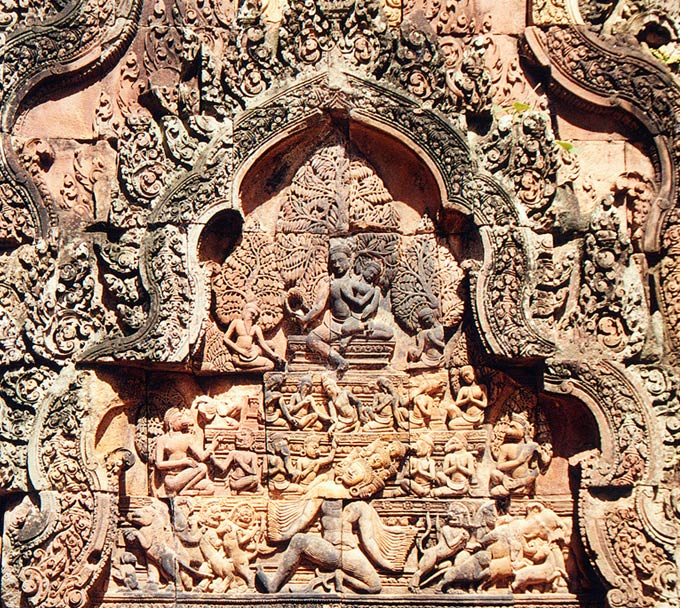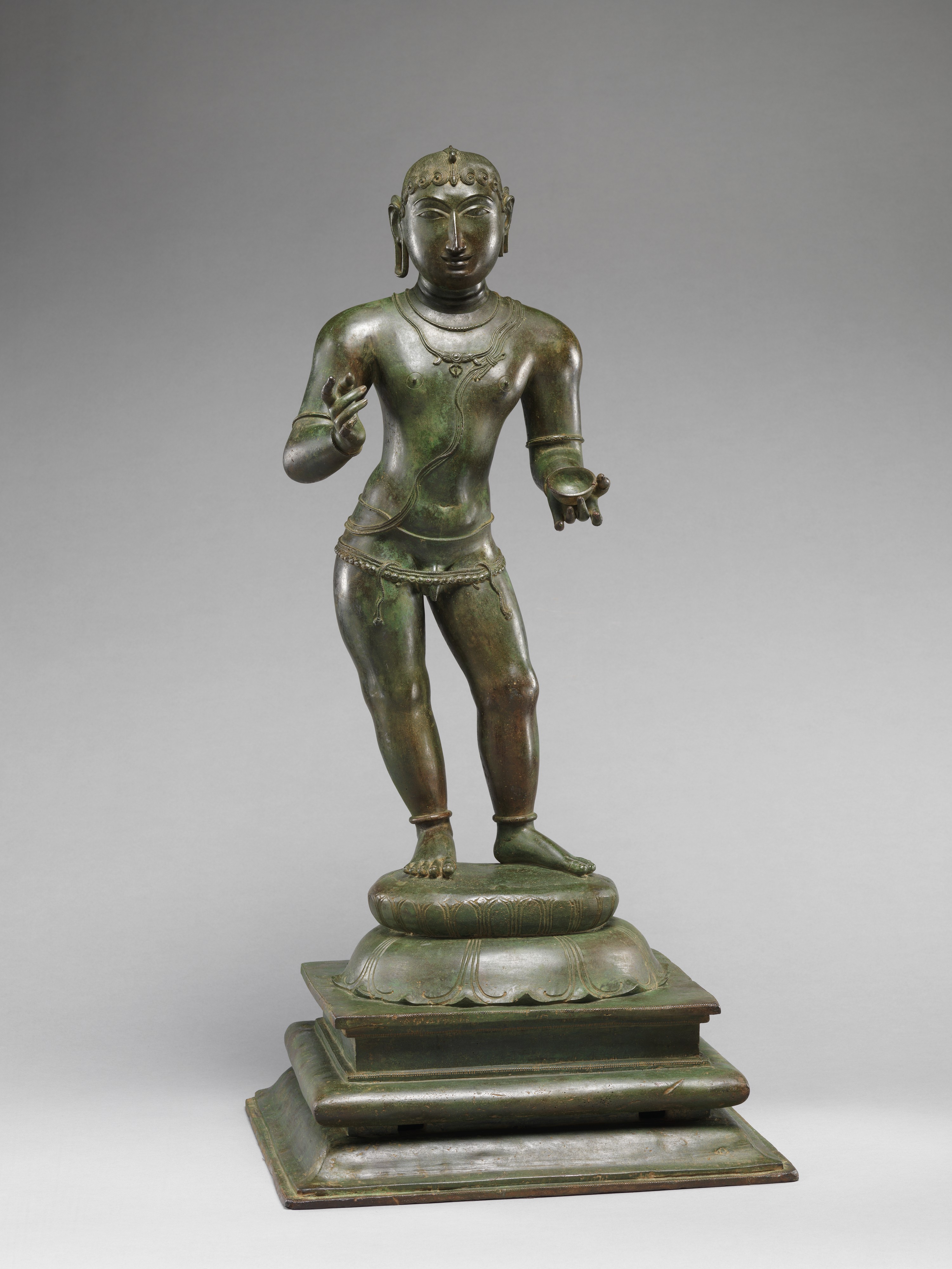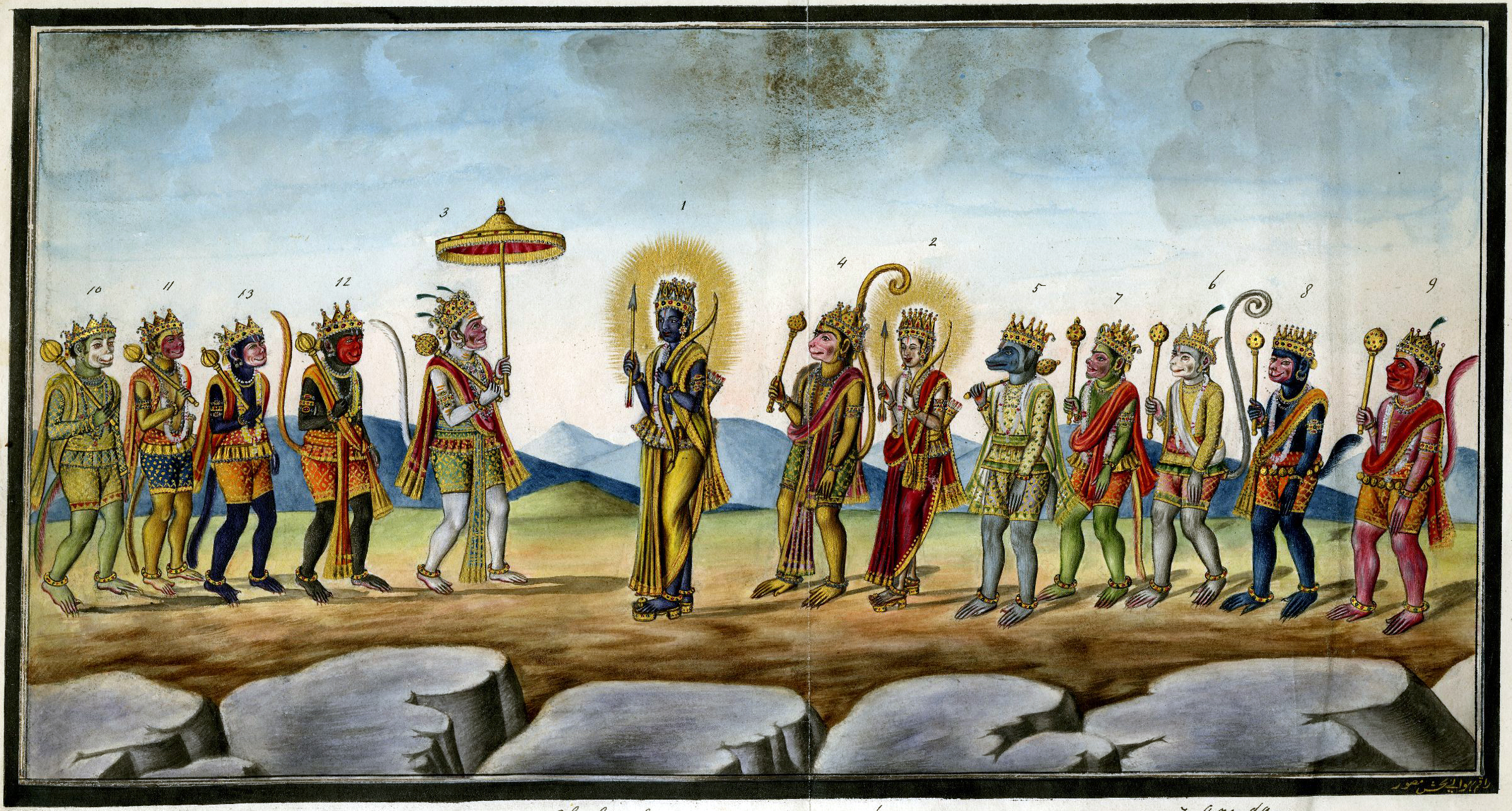|
Ravananugraha
Ravananugraha or Ravananugraha-murti ("form showing favour to Ravana") is a benevolent aspect of the Hindu god Shiva, depicted seated on his abode Mount Kailash with his consort Parvati, while the ''rakshasa''-king (demon-king) Ravana of Lanka attempts to uproot it. According to Hindu scriptures, Ravana once tried to lift Mount Kailash, but Shiva pushed the mountain into place, and trapped Ravana beneath it. For a thousand years, the imprisoned Ravana sang hymns in praise of Shiva, who finally blessed him and granted him an invincible sword and a powerful linga (Shiva's aniconic symbol, Atmalinga) to worship. The theme is popular in Indian art and is found as early as the Gupta- Pallava era (300–600 CE). Legend The ''Uttara Kanda'' of the Hindu epic ''Ramayana'' records: the ten-headed, twenty-armed mighty King Ravana defeated and looted Alaka – the city of his step-brother and god of wealth Kubera, situated near Mount Kailash. After the victory, Ravana was returning to L ... [...More Info...] [...Related Items...] OR: [Wikipedia] [Google] [Baidu] |
Ravana
Ravana (; , , ) is a rakshasa king of the island of Lanka, and the chief antagonist of the Hindu epic ''Ramayana'' and its adaptations. In the ''Ramayana'', Ravana is described to be the eldest son of sage Vishrava and rakshasi Kaikesi. He abducted Prince Rama's wife Sita and took her to his kingdom of Lanka, where he held her in the Ashoka Vatika. Later, Rama, with the support of vanara King Sugriva and his army of vanaras, launched an invasion against Ravana in Lanka. Ravana was subsequently slain and Rama rescued his beloved wife Sita. Ravana is widely portrayed to be an evil character, though he also has many qualities that make him a learned scholar. He was well-versed in the six shastras and the four Vedas. Ravana is also considered to be the most revered devotee of Shiva. Images of Ravana are seen associated with Shiva at some temples. He also appears in the Buddhist Mahayana text ''Laṅkāvatāra Sūtra'', in Buddhist Ramayanas and Jatakas, as well as in Jain Ra ... [...More Info...] [...Related Items...] OR: [Wikipedia] [Google] [Baidu] |
Shiva Tandava Stotra
''Shiva Tandava Stotra'' ( sa, शिवताण्डवस्तोत्र, śiva-tāṇḍava-stotra) is a Sanskrit ''stotra'' (hymn) that is dedicated to the Hindu deity, Shiva. Its authorship is traditionally attributed to Ravana, the King of Lanka, who is considered to be a great devotee of Shiva, composed during his plea for moksha. Etymology ''Shiva'' refers to the name of the destroyer deity, ''Tandava'' or ''Tandavam'' refers to a frantic dance, and ''Stotra'' or ''Stotram'' refers to a panegyric, a hymn of praise. This Sanskrit hymn is also referred to as ''Shiva Tandava Stotram'' in English. Verse The stotra has 16 syllables per line of the quatrain, with ''laghu'' (short syllable) and ''guru'' (long syllable) characters alternating; the poetic meter is iambic octameter by definition. There are 17 quatrains in total. Both the ninth and tenth quatrains of this hymn conclude with lists of Shiva's epithets as destroyer, even the destroyer of death itself. Alli ... [...More Info...] [...Related Items...] OR: [Wikipedia] [Google] [Baidu] |
Mount Kailash
Mount Kailash (also Kailasa; ''Kangrinboqê'' or ''Gang Rinpoche''; Standard Tibetan, Tibetan: གངས་རིན་པོ་ཆེ; ; sa, कैलास, ), is a mountain in the Ngari Prefecture, Tibet Autonomous Region of China. It has an altitude of . It lies in the Gangdise Shan, Kailash Range (Gangdisê Mountains) of the Transhimalaya, in the western part of the Tibetan Plateau. Mount Kailash is less than 100 km towards the north from the western trijunction of the borders of China, India, and Nepal. Mount Kailash is located close to Lake Manasarovar and Lake Rakshastal. The sources of four major Asian rivers lie close to this mountain and the two lakes. These rivers are the Indus River, Indus, the Sutlej, the Brahmaputra River, Brahmaputra, and the Karnali River, Karnali (a tributary of the Ganges). Mount Kailash is considered sacred in four religions: Hinduism, Buddhism, Jainism and Bon. Etymology The mountain is known as “'” (; var. ' ) in Sanskrit. The nam ... [...More Info...] [...Related Items...] OR: [Wikipedia] [Google] [Baidu] |
Halebidu
Halebidu (IAST: Haḷēbīḍ, literally "old capital, city, encampment" or "ruined city") is a town located in Hassan District, Karnataka, India. Historically known as Dorasamudra (also Dwarasamudra), Halebidu became the regal capital of the Hoysala Empire in the 11th century CE. In the modern era literature it is sometimes referred to as Halebeedu or Halebid as the phonetic equivalent, a local name after it was damaged and deserted after being ransacked and looted twice by the forces of the Delhi Sultanate in the 14th century. Halebidu is home to some of the best examples of Hindu and Jain temples with Hoysala architecture. These show the breadth of Hindu artwork traditions – Shiva, Vishnu, Devi and Vedic deities – fused into the same temple complex, depicted with a diversity of regional heritages, along with inscriptions in scripts from South and North India. The Hindu temples include Jaina reliefs in its panel. Similarly, the Jaina artwork includes the different Tirth ... [...More Info...] [...Related Items...] OR: [Wikipedia] [Google] [Baidu] |
Ramayana
The ''Rāmāyana'' (; sa, रामायणम्, ) is a Sanskrit literature, Sanskrit Indian epic poetry, epic composed over a period of nearly a millennium, with scholars' estimates for the earliest stage of the text ranging from the 8th to 4th centuries BCE, and later stages extending up to the 3rd century CE. ''Ramayana'' is one of the two important epics of Hinduism, the other being the ''Mahabharata, Mahābhārata''. The epic, traditionally ascribed to the Maharishi Valmiki, narrates the life of Sita, the Princess of Janakpur, and Rama, a legendary prince of Ayodhya city in the kingdom of Kosala. The epic follows his fourteen-year exile to the forest urged by his father King Dasharatha, on the request of Rama's stepmother Kaikeyi; his travels across forests in the South Asia, Indian subcontinent with his wife Sita and brother Lakshmana, the kidnapping of Sita by Ravana – the king of Lanka, that resulted in war; and Rama's eventual return to Ayodhya to be crowned kin ... [...More Info...] [...Related Items...] OR: [Wikipedia] [Google] [Baidu] |
Mahabaleshwar Temple, Gokarna
The Mahabaleshwar Temple, Gokarna is a 4th-century CE Hindu temple located in Gokarna, Uttara Kannada district, Karnataka state, India which is built in the classical Dravidian architectural style. It is a site of religious pilgrimage. The temple faces the Gokarna beach on the Arabian Sea. The temple deifies the ''Pranalinga'' ("the reality of God which can be captured by the mind") also called ''Atmalinga'' or ''Shiva Linga''Subramuniyaswami S. S''Dancing with Siva: Hinduism's Contemporary Catechism''Himalayan Academy Publications 2003 p. 847 Accessed 28 October 2010. In legend, it is said that the deity of the temple will bestow immense blessings to devotees, even to those who only glimpse it.Abram D''Rough Guide to Goa''Rough Guides 2003 p. 234 - 237. Accessed 27 May 2010. [...More Info...] [...Related Items...] OR: [Wikipedia] [Google] [Baidu] |
Ganesha
Ganesha ( sa, गणेश, ), also known as Ganapati, Vinayaka, and Pillaiyar, is one of the best-known and most worshipped deities in the Hindu pantheon and is the Supreme God in Ganapatya sect. His image is found throughout India. Hindu denominations worship him regardless of affiliations. Devotion to Ganesha is widely diffused and extends to Jains and Buddhists and includes Nepal, Sri Lanka, Thailand, Indonesia (Java and Bali), Singapore, Malaysia, Philippines, and Bangladesh and in countries with large ethnic Indian populations including Fiji, Guyana, Mauritius, and Trinidad and Tobago. Although Ganesha has many attributes, he is readily identified by his elephant head. He is widely revered, more specifically, as the remover of obstacles and thought to bring good luck; the patron of arts and sciences; and the deva of intellect and wisdom. As the god of beginnings, he is honoured at the start of rites and ceremonies. Ganesha is also invoked as a patron of letters ... [...More Info...] [...Related Items...] OR: [Wikipedia] [Google] [Baidu] |
Veena
The ''veena'', also spelled ''vina'' ( sa, वीणा IAST: vīṇā), comprises various chordophone instruments from the Indian subcontinent. Ancient musical instruments evolved into many variations, such as lutes, zithers and arched harps.Vina: Musical Instrument Encyclopædia Britannica (2010) The many regional designs have different names such as the ''Rudra veena'', the ''Saraswati veena'', the ''Vichitra veena'' and others. The North Indian ''rudra veena'', used in Hindustani classical music, is a stick zither. About 3.5 to 4 feet (1 to 1.2 meters) long to fit the measurements of the musician, it has a hollow body and two large resonating gourds under each end. It has four main strings which are melodic, and three auxiliary drone strings. [...More Info...] [...Related Items...] OR: [Wikipedia] [Google] [Baidu] |
Tevaram
The ''Thevaram'' ( ta, தேவாரம், ), also spelled ''Tevaram'', denotes the first seven volumes of the twelve-volume collection ''Tirumurai'', a Śaiva narrative of epic and puranic heroes, as well as a hagiographic account of early Saiva saints set in devotional poetry. The ''Thevaram'' volumes contain the works of the three most prominent Saiva Tamil poets of the 7th and 8th centuries: Sambandar, Appar, and Sundarar. The three poets were not only involved in portraying their personal devotion to Shiva, but also engaged a community of believers through their songs. Their work is an important source for understanding the Śaiva Bhakti movement in the early medieval South India. In the 10th century, during the reign of Rajaraja I of the Chola dynasty, these poets' hymns were collected and arranged by Nambiyandar Nambi. Starting with the ''Thevaram'' along with the rest of ''Tirumurai'' and ending with the ''Periya Puranam'', Tamil Saivism acquired a canonical set of ... [...More Info...] [...Related Items...] OR: [Wikipedia] [Google] [Baidu] |
Vanara
In Hindu, Vanara ( sa, वानर, , forest-dwellers) are either monkeys, apes, or a race of forest-dwelling people. In the epic the ''Ramayana'', the Vanaras help Rama defeat Ravana. They are generally depicted as humanoid apes, or human-like beings. Etymology There are three main theories about the etymology of the word "Vanara": * Aiyanar suggests that ''vanara'' means "monkey" derived from the word ''vana'' ("forest"), Literally meaning "belonging to the forest" Monier-Williams says it is probably derived from ''vanar'' (lit. "wandering in the forest") and means "forest-animal" or monkey. * Devdutt Pattanaik suggests that it derives from the words ''vana'' ("forest"), and ''nara'' ("man"), thus meaning "forest man" and suggests that they may not be monkeys, which is the general meaning. * It may be derived from the words ''vav'' and ''nara'', meaning "is it a man?" (meaning "monkey") or "perhaps he is man". Identification Although the word Vanara has come to mean ... [...More Info...] [...Related Items...] OR: [Wikipedia] [Google] [Baidu] |






